DDR3-1600 for Core i7: Corsair Dominator TR3X6G1600C8D vs. Cost-Efficiency

Everything is great about triple-channel 6GB DDR3-1600 memory kits except the price. Let’s investigate this memory in detail and find out if this investment is justified or if there are ways of saving a few bucks without losing any of the performance.
When Intel launched Core i7 processors they made a real gift for the memory manufacturers. These processors not only have a built-in memory controller compatible only with DDR3 SDRAM, but this controller has triple-channel structure, which makes the use of dual-channel DDR3 SDRAM in LGA1366 systems questionable, although it was widely spread in previous generation platforms. So, most users switching to a new high-performance platform have to purchase new memory kits optimized specifically for Core i7 series CPUs.
Overclockers found themselves in an even more difficult situation. The peculiarities of the integrated memory controller limit the memory modules choice for the platforms based on the new CPUs. The memory controller receives its power from the same voltage as the memory, which means that Core i7 processors will not allow increasing it significantly – a measure commonly used by overclockers to improve the SDRAM frequency potential.
All this makes wealthy computer enthusiasts face the problem of choosing the most optimal DDR3 SDRAM kit for their needs. Overclocker memory makers try to make it easier for the users by offering special memory kits for LGA1366 systems. They have three distinguishing features. First, they consist of three identical modules, each 1GB or 2GB capacity. Second, they include pretty fast DDR3 SDRAM modules working at 1333, 1600 1866 or even 2000MHz. And third, these modules are designed to work at not very high voltage settings that do not exceed 1.65V.
So far we have already tested two kits like that from Kingston: Kingston HyperX KHX14900D3T1K3/3GX and Kingston HyperX KHX16000D3K3/3GX. Now time has come to check out popular solutions from Corsair, and our today’s review will do that. We are actually going to talk about a relatively expensive 6GB kit, but we will also provide our recommendations to users with limited budget that may consider that much memory to be a little overboard.
Again on Voltages
Before we move on to the specific memory kit in question, that is going to be the main hero of our today’s review, we would like to talk once again about the real need for choosing low-voltage memory. Because of this particular factor it is impossible to use in LGA1366 platforms most overclocker DDR3 solutions available by users and in retail channels. And since users more often start to doubt the need for the low recommended maximum voltage, we simply couldn’t leave out this important topic.
First of all, I have to say that the 1.65V number is not just some number. Although the standard voltage for DDR3 SDRAM is 1.5V, Intel engineers believe that the slightly increased maximum voltage is safe for LGA1366 systems. Mainboard makers stand by them warning about possible processor damage if VDIMM ever exceeds 1.65V. And these warnings and concerns emerge for a reason. The thing is that Core i7 processors use VDIMM to power the integrated memory controller, too. That is exactly why it is so dangerous to increase this parameter excessively.
At the same time, there is an opinion that when the voltage of the CPU Uncore part is raised past 1.1V, the maximum VDIMM settings may be increased, too. It is partially true, because processor logic is more sensitive not to the absolute voltages but to the ratios between the signal levels. Therefore, it is considered possible to increase the memory voltage past 1.65V only if Uncore processor voltage is increased at the same time. Note that the ratio between the memory and Uncore voltages should not exceed 1.5: only in this case the consolidated voltage increase may be considered relatively safe. At least our practical experience in this matter suggests that you will be able to prolong the life of your CPU if you follow this recommendation carefully.
However, there is another danger here. If you increase Uncore and memory voltages, the heat dissipation of the CPU part containing L3 cache and the memory controller will increase rapidly. There is no way to control this process, because Intel engineers didn’t integrate any thermal or alarm diodes in this part of their CPU die: all diodes inside Core i7 processors are exclusively inside the actual computational cores. In other words, extreme increase of the VDIMM and VUncore may lead to systematic uncontrollable heating of the integrated memory controller, which may eventually lead to very sad consequences. Core i7 may degrade and with the time even die without proper cooling.
Therefore, we support Intel’s recommendations and strongly suggest that you should equip your LGA1366 systems only with those memory modules that do not require increasing their voltage over 1.65V.
DDR3-1600 SDRAM: Optimal Choice for Core i7 Overclocking
Core i7-920 has become the most popular CPU in the Core i7 series. The reason for this high demand is very simple: it is the cheapest LGA1366 processor with an excellent overclocking potential. According to the overclocking statistics, with air-cooling these CPUs can reach 3.8-4.0GHz with Hyper-Threading technology enabled or 4.0-4.2GHz with this technology disabled.
Keeping in mind that Core i7-920 uses 20x multiplier (or 21x available through Turbo Boost technology), most overclockers try to get their system to work at the BCLK base generator frequency increased from the nominal 133MHz to 180-210MHz. Taking into account that Core i7 processors support even memory frequency multipliers starting from 6x, the list of the most interesting nominal rates for the overclocker memory includes the following values:
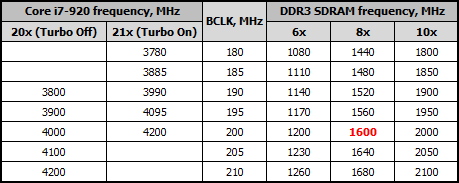
As you can see from the table above, the memory with 1600MHz frequency will be of primary interest to computer enthusiasts willing to overclock their Core i7-920 based platforms. Slow DDR3-1200 will most likely be rejected because of insufficient bandwidth. As for fast DDR3-2000, it may become a worthy part of an overclocker system, but on the one hand, it is too expensive, and on the other it is a little tricky to actually use. The technical difficulties we are talking about mostly come from the fact that the L3 cache of Core i7 processors should work at least at twice the frequency of the memory. Therefore, to ensure its stability at 4.0GHz frequency (instead of the default 2.13GHz), you may need to increase the Uncore voltage quite substantially, which may end up dangerously high for the semiconductor processor die.
Corsair Dominator TR3X6G1600C8D
Well, it is absolutely evident that the majority of computer enthusiasts building an LGA1366 platform will go for the special DDR3-1600 memory kits. And today we are going to check out one of the solutions currently offered by one of the leaders in the overclocker memory field – Corsair Company. For our first encounter we got a Corsair Dominator TR3X6G1600C8D memory kit that is widely available in retail these days. It includes three DDR3 SDRAM modules, 2GB each that are designed to work at 1600MHz frequency.
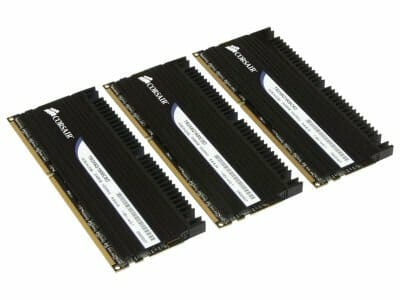
The modules ship in a very roomy plain cardboard box without any attractive design on it:
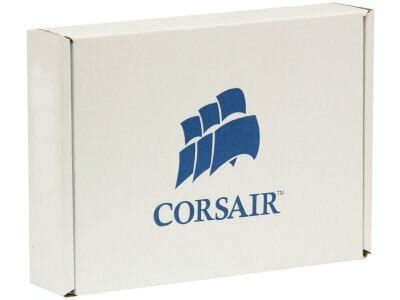
Each of the three memory DIMMs inside the box is wrapped into its own individual blister bag. However, it is not the packaging thatches our eye, but the unique heat-spreaders on the modules:
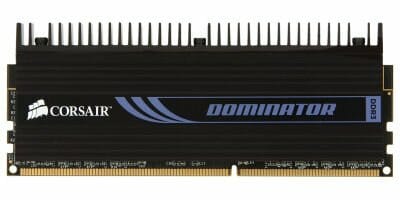
We would like to remind you that Dominator series from Corsair has been using taller heat-spreaders for a few years already. They cool not only the actual memory chips, but also the printed circuit board that receives a substantial amount of heat from the memory chips. First generation Corsair Dominator modules are equipped with four comb-shaped heatsink arrays: the external pair of these heatsinks contacts the actual memory chips, while the internal pair is mounted onto the PCB surface and serves to dissipate the PCB heat.
New Dominator modules designed by Corsair engineers for Core i7 systems boast a slightly different design. No, the difference is not in the geometrical dimensions of the modules. Dominator modules are still pretty tall, which may make it difficult to use them in systems with large CPU coolers and DIMM slots close to the processor socket. This time, however, Corsair uses heat-spreaders made of three aluminum parts instead of four. A pair of rigged heat-spreaders covers the DIMM surface and contacts the chips and the PCB at the same time.
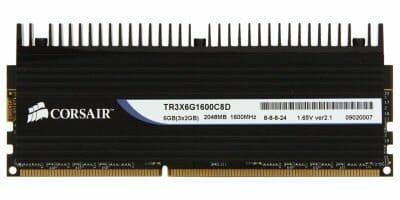
However, unlike the previous generation Dominator modules, the contact between the new heat-spreaders and the chips has become pretty relative, which you can very well see if you look at the modules from the side. The heat-spreaders are about half a millimeter away from the top of the chips and the gap is filled pretty carelessly with some thermal glue, which doesn’t cover even half of the chips surface.

The top comb-shaped part of the heat-spreaders has also changed. Now it is a separate part that is attached to the heat-spreader contacting the memory chips plates with screws.
The design has definitely been changed for a reason. A removable heatsink at the top suggests that there might be something else installed instead of it. For example, it could be a heatsink of different shape and color, like in the Dominator GT series:
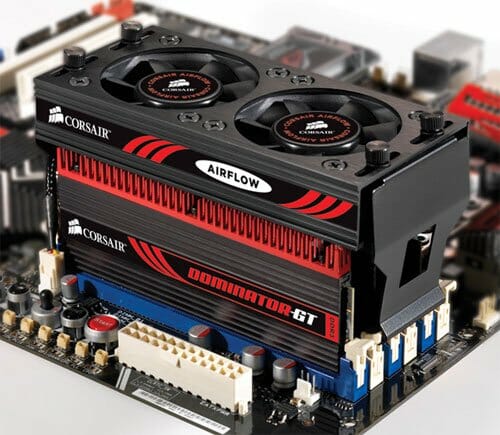
It could also be a water block that Corsair is going to offer a little later:
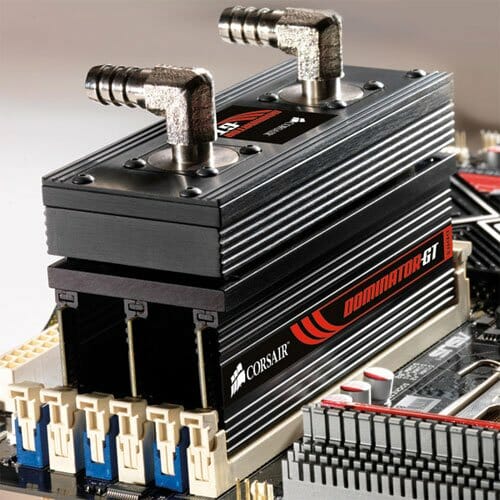
According to the manufacturer, the specifications of the Corsair Dominator TR3X6G1600C8D kit look as follows:
- 3 DDR3 SDRAM modules, each 2GB in capacity;
- 1600MHz frequency;
- CAS Latency 8, 8-8-8-24 timings;
- 1.65V voltage.
I have to say that these were the fastest DDR3-1600 memory modules from Corsair for Core i7 systems at the time of the review. Unfortunately, we couldn’t find any Corsair memory kits with more aggressive timings, unlike Corsair immediate competitors, who have quite a few to offer.
Corsair Dominator TR3X6G1600C8D memory supports Intel Extreme Memory Profiles (XMP 1.2), which is absolutely logical considering that it is designed for Core i7 systems. The profiles supported within this technology contain settings for the nominal DDR3-1600 mode with the default 8-8-8-24 timings as well as for low-frequency DDR3-1200 mode with 6-6-6-18 timings. Both profiles require voltage increase to 1.65V.
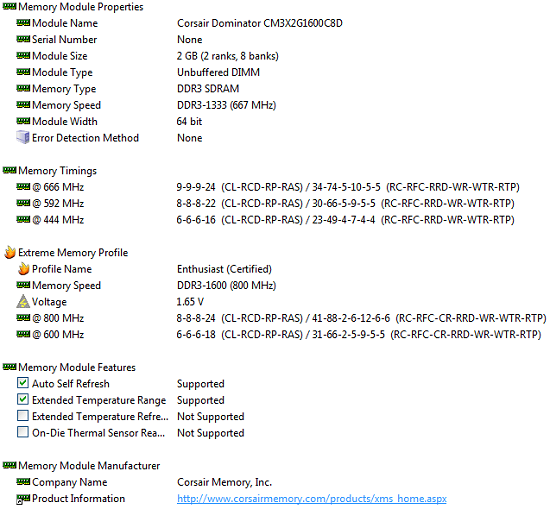
In addition to the supported operational modes declared in XMP, the modules SPD contains a few other “lite” profiles that should ensure compatibility with a variety of mainboards.
Testbed Configuration
To investigate the overclocker potential of our Corsair Dominator TR3X6G1600C8D kit we put together the following platform:
- CPU: Intel Core i7-920 (Bloomfield, 2.66GHz, 8MB L3);
- CPU cooler: Scythe Mugen with Enermax Magma UCMA12 fan (1500RPM);
- Mainboard: Gigabyte GA-EX58-UD5 (Intel X58 Express);
- Memory: Corsair Dominator TR3X6G1600C8D (DDR3-1600 SDRAM, 3 x 2GB, 8-8-8-24);
- Graphics card: ATI Radeon HD 4870;
- HDD: Western Digital Raptor WD1500AHFD;
- PSU: SilverStone SST-ST85ZF (850W);
- OS: Microsoft Windows Vista x64 SP1.
Overclocking Experiments
During our practical experiments with Corsair Dominator TR3X6G1600C8D memory modules we tried to find out the maximum frequency and best timings, with which they remained stable. To accomplish this we used a hreat Memtest86+ 2.11 benchmark that checks the work of the memory subsystem under serious load.
First we found out that the modules can work stably at 1.65V voltage and 1600MHz frequency not only with their nominal settings of 8-8-8-24, but also in a more aggressive mode. This DDR3-1600 memory remained fully functional with its timings set at 8-8-7-24.
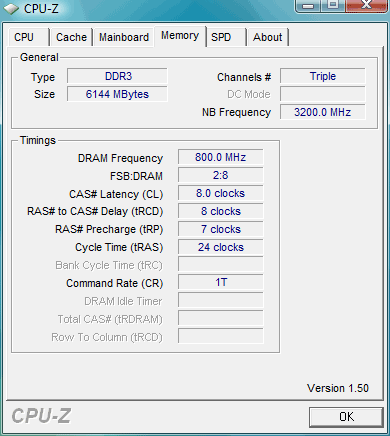
We have also studies the potential of this memory kit with different timings settings. The table below shows the maximum frequencies we managed to achieve with different timings. These Corsair Dominator tests were also performed at 1.65V voltage and 1T Command Rate.
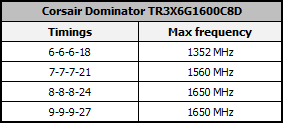
There are two groups of results that are of primary interest to us here. We have to say that the overclocking potential of the tested memory kit turned out quite insignificant compared with the claimed 1600MHz spec. Even with more lenient timings of 9-9-9-27, Corsair Dominator TR3X6G1600C8D could be overclocked only at 1650MHz – the frequency that can also be reached with the default timings.
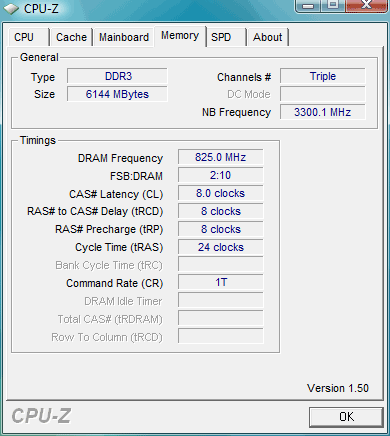
However, these memory modules performed very well with aggressive 6-6-6-18 timings that have been included into the supported XMP profile not for nothing. With these timings settings Corsair Dominator TR3X6G1600C8D remained stable at over 1333MHz frequency. Although, we were not impressed by this achievement, especially after the results demonstrated by Kingston HyperX KHX14900D3T1K3/3GX.
Performance
Besides the overclocking experiments performed on Corsair Dominator TR3X6G1600C8D, we also wanted to find out if the use of DDR3-1600 SDRAM is overall justified for an overclocked LGA1366 system. That is why we are going to measure the performance of a system based on an overclocked Core i7 processor and DDR3 SDRAM with different latencies and frequencies.
We used the above described system with the Core i7-920 processor working at 4.0GHz frequency. The frequency was obtained as 20 x 200MHz. The processor L3 cache frequency was increased to 3.2GHz.
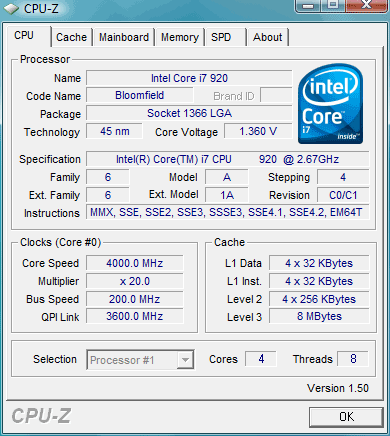
By raising the clock generator base frequency to 200MHz we could clock the memory at 1200MHz (with 6x multiplier) or at 1600MHz (with 8x multiplier). Overclockers working with a Core i7-920 processor will most likely face the exact same or very similar choice. So, our further comparison will show if overclockers will benefit from using memory kits like Corsair Dominator TR3X6G1600C8D, or if regular DDR3-1333 memory working at lower frequencies with 6x multiplier will not be a bottleneck for Core i7 based platforms. In fact, the answer to this question is not so evident, because the new Intel processor boasts a new triple-channel memory controller providing pretty high bandwidth and low latency even with slow DDR3 SDRAM modules.
First we ran a synthetic Everest Ultimate Edition 5.0 test that helped us determine the practical characteristics of the memory subsystem.
DDR3-1600 SDRAM does work at faster speed, however, the results differ not as significantly as we may have expected. DDR3-1600 with 8-8-8-24 timings shows no more than 10% advantage in read speed and latency (these are the most important parameters) over DDR3-1200 with most widely spread timings of 7-7-7-20.
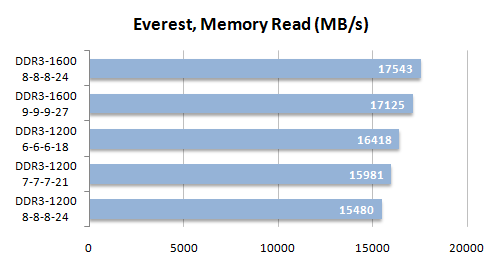
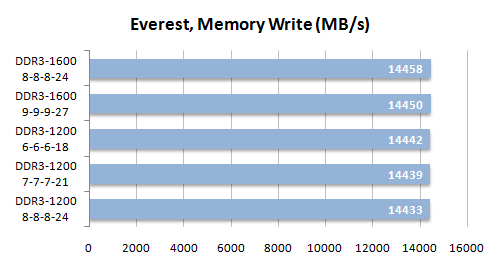
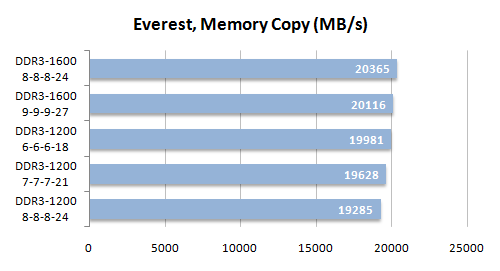
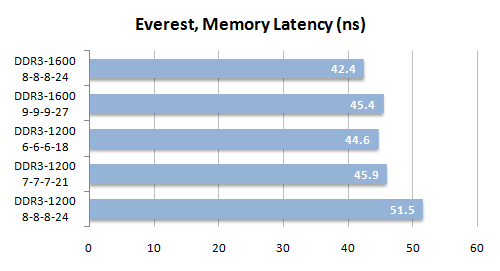
This small but evident advantage of DDR3-1600 SDRAM shows in benchmarks based on real applications:
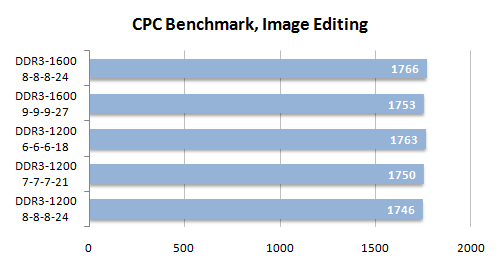
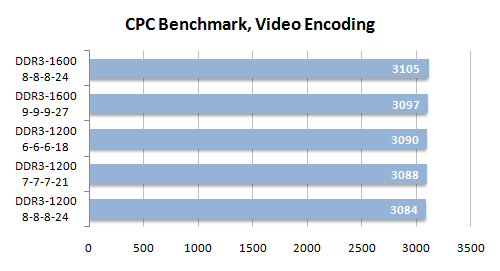
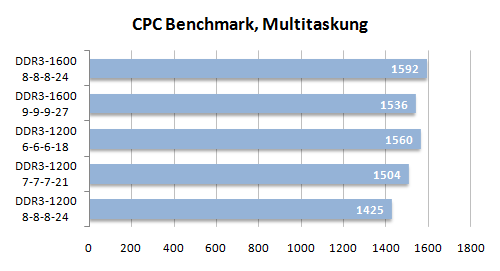
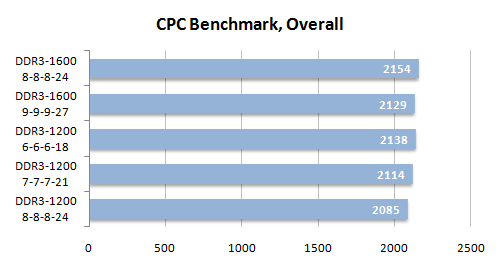
Complex CustomPC Benchmark based on real applications reveals minimal discrepancies during the tests of overclocked systems equipped with triple-channel memory working at 1200 and 1600MHz. However, the system equipped with DDR3-1600 may be up to 12% ahead of the DDR3-1200 rival in a multi-threaded benchmark, which is very sensitive to memory subsystem configuration.
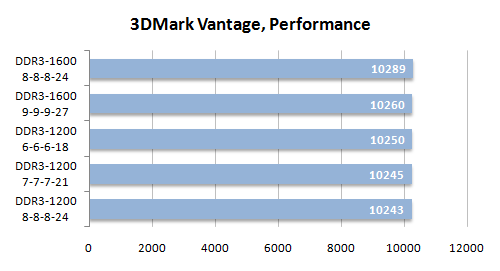
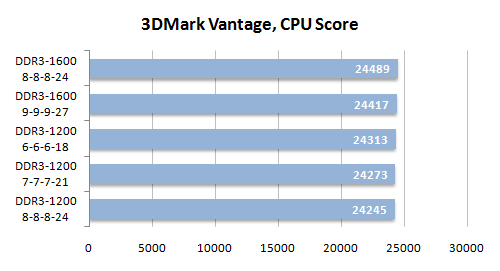
3DMark Vantage benchmark testing the system performance in gaming applications produces results that differ only by 1-2% at the most, despite the significantly different latencies and frequencies of the memory subsystems.
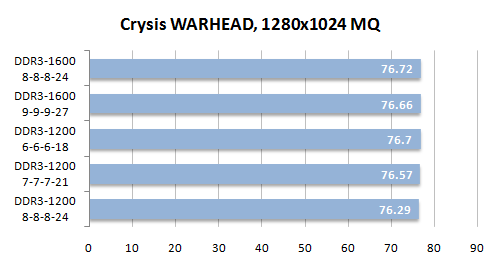
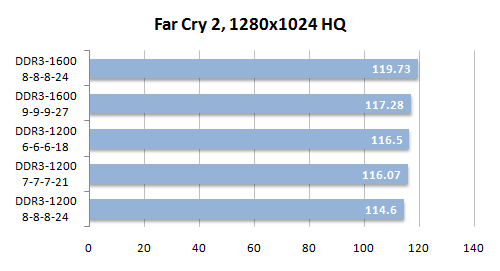
Real games, especially FarCry 2, reveal a little bigger performance difference between the systems equipped with different memory configurations. In this game, for instance, a system with triple-channel DDR3-1600 with 8-8-8-24 timings works 3% faster than a similar system equipped with DDR3-1200 SDRAM with 7-7-7-20 timings. And even faster DDR3-1200 SDRAM with aggressive 6-6-6-18 timings will fall behind any DDR3-1600 similar to Corsair Dominator TR3X6G1600C8D by noticeable 2.7%.
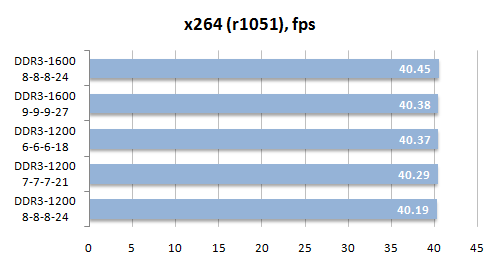
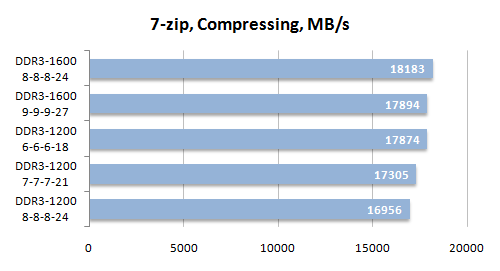
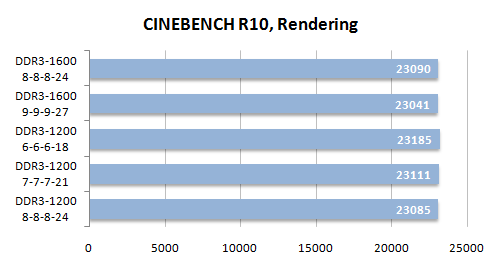
Video encoding and final rendering barely depend on the memory subsystem performance. However, it is a completely different story with archiving utilities. DDR3-1600 demonstrates 5-7% advantage here.
In conclusion we decided to run a new computation MaxPi2 benchmark that calculates 32 million digitals of the π. This benchmark came to replace the legendary SuperPi test that used to be very sensitive to the memory subsystem changes.
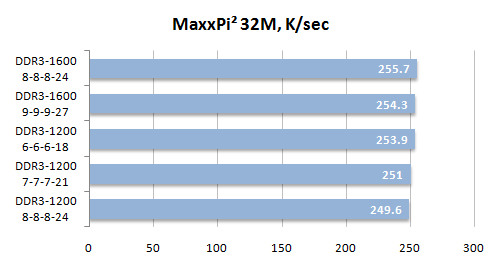
The new benchmark proved just as good as the old one. The effect of the memory subsystem performance on the test results is clearly seen on the diagram. Triple-channel DDR3-1600 SDRAM, like the Corsair Dominator TR3X6G1600C8D tested today, will feel totally at home in an overclocked Core i7 based system.
According to the obtained results, it is fairly hard to tell how well expensive DDR3-1600 SDRAM justifies its price. It delivers a relatively insignificant performance advantage over DDR3-1200 of 1-2% on average. Only in a several applications fast memory provides over 5% performance boost. It is enough to make up for the high price? – Well, one could argue about it, depending on the usage model for the system and the individual obsession. So, we decided to refrain from any specific recommendations in this particular matter.
Saving Easy: Corsair Dominator TR3X3G1600C8D
Our tests showed that the use of overclocker DDR3-1600 SDRAM may make some practical sense for those enthusiasts who want the highest performance at any price. We can’t deny that high-speed memory does ensure higher performance in Core i7 platforms. At the same time, kits like Corsair Dominator TR3X6G1600C8D are quite expensive and this price may scare away a few potential buyers.
Luckily, Corsair took care of these users and is offering a similar kit, which contains three 1GB modules instead of three 2GB ones. This kit is called Corsair Dominator TR3X3G1600C8D.
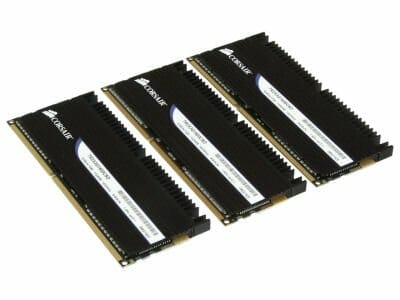
Corsair Dominator TR3X3G1600C8D memory modules look just like their elder counterparts. Their internal structure is also almost the same. They only differ by the number of chips. While Corsair Dominator TR3X6G1600C8D features double-sided 16-chip modules, the 3GB TR3X3G1600C8D kit contains single-sided modules, 8 chips on each.
As a result, no wonder that the nominal specs of the “junior” Corsair Dominator TR3X3G1600C8D kit differ only by the memory capacity from the 6GB one:
- 3 DDR3 SDRAM modules, each 1GB in capacity;
- 1600MHz frequency;
- CAS Latency 8, 8-8-8-24 timings;
- 1.65V voltage.
Both kits have the same XMP profiles contents:
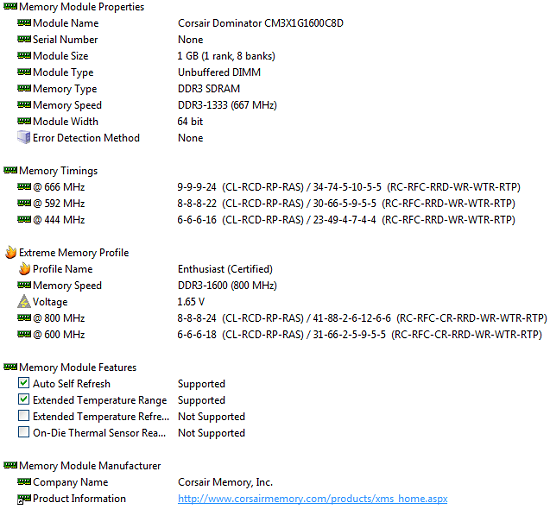
But that’s not all. Our practical tests showed that Corsair Dominator TR3X3G1600C8D memory modules overclock almost the same as Corsair Dominator TR3X6G1600C8D kit. So, the Corsair Dominator TR3X3G1600C8D modules may be of interest to those users who do not do anything requiring large memory capacities.
Although memory makers, like Corsair, for instance, point out that their 6GB memory kits are superior over their 3GB kits, you can actually feel this difference only in specific applications working with large amounts of data. Most general-purpose applications running on home systems can do just fine with 3GB of memory. Especially, since it is close to the maximum memory capacity supported by widely spread 32-bit operating systems. For example, the set of benchmarks we used today turned out almost indifferent to the change in RAM capacity from 3GB to 6GB. We could only notice the effect from having more memory only by the time it took our OS, applications and gaming levels to load.
However, we can suggest a different solution for those who want to save a bit of money. And it may even turn out much more interesting, too.
Saving Smart: 2 x 2GB in an LGA1366 System
3GB of RAM do not look too good in a system based on a high-performance Core i7 processor. The today’s “de facto” standard is to use 4GB of memory. And the CPU-Z results statistics proves it.
When LGA775 systems were all over the place, it was considered decent to equip your system with two 2GB memory sticks. After that it is psychologically hard to go to one 1GB smaller memory size. However, the price of 6GB DDR3 SDRAM kits, like Corsair Dominator TR3X6G1600C8D, is pretty high and may make it difficult for them to win the market. Especially, since there are not too many enthusiasts who would need so much memory.
In this case, it is absolutely natural to try and use dual-channel memory kits of 2GB modules in the new LGA1366 systems. And even though the Core i7 memory controller will not work at its full speed, it is possible that having fewer active channels will not have too serious of an influence on the resulting performance. And it will let us conclude if it makes sense to equip new generation systems with 4GB of RAM instead of 3GB or 6GB.
Well, benchmarks will help us answer this question once and for all. For our experiments on the above described platform using a 4GHz Core i7-920 processor we took two 2GB DDR3-1600 SDRAM modules and compared the results with those obtained on the exact same system equipped with three modules like that.
First let’s check out synthetic benchmarks.
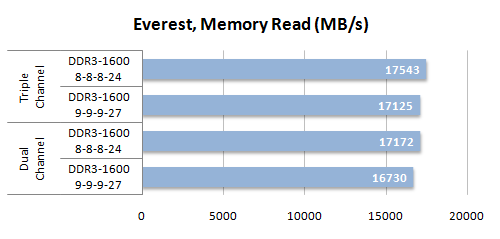
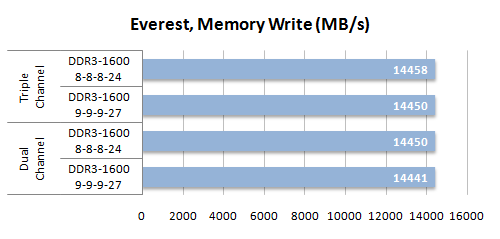
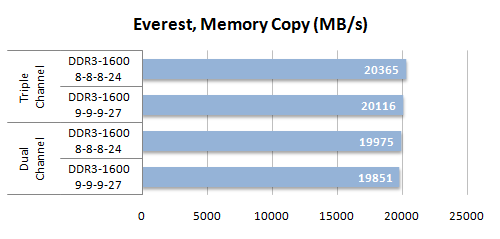
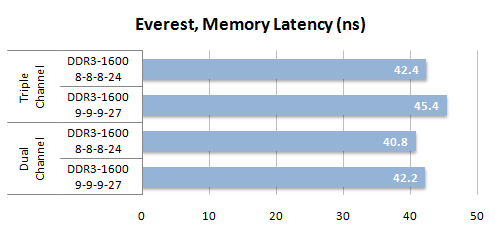
The results are absolutely astounding. Despite our expectations and 33% lower theoretical bandwidth, having two memory channels instead of three cost us only 2% of the practical bandwidth. As for the latency, it didn’t get any lower at all. So, the results difference in real applications may turn out quite small.
Let’s check it out now.
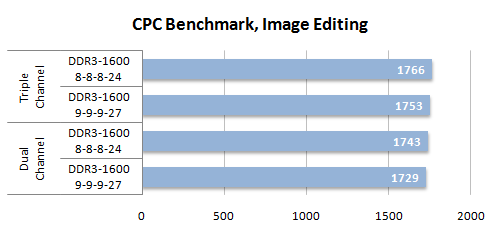
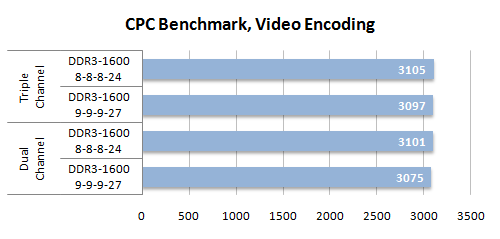
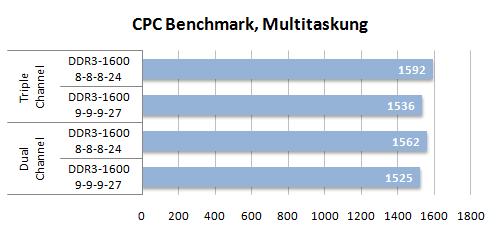
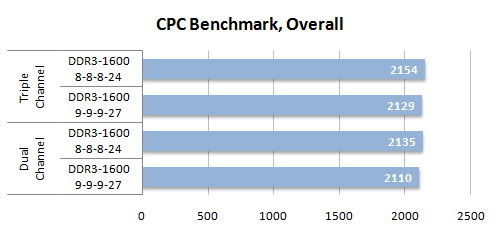
Now that we have just discussed the performance in synthetic benchmarks, the obtained results seem to be absolutely logical. But nevertheless, we can’t deny that the performance difference between dual- and triple-channel memory is truly minimal. Dual-channel DDR3-1600 SDRAM falls only 2% behind triple-channel memory with identical timings settings even in multi-threading test, which is very sensitive to the memory subsystem performance. And if we consider the average results of the CustomPC Benchmark, the average advantage of three memory channels vs. two will be less than 1%.
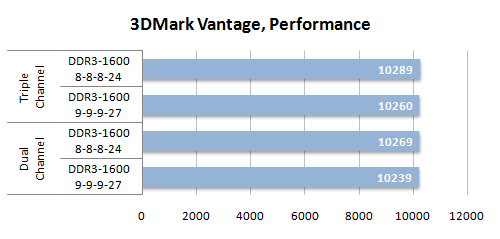
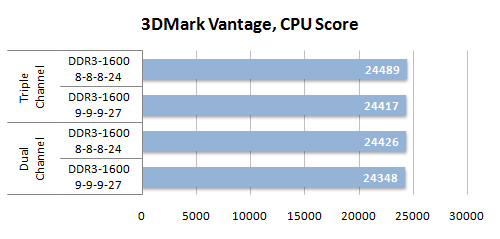
There is barely any performance difference between the systems working with two and three memory channels in applications that are not too sensitive to the timings changes.
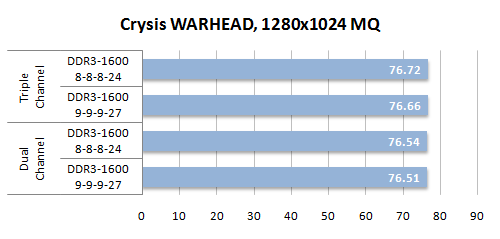
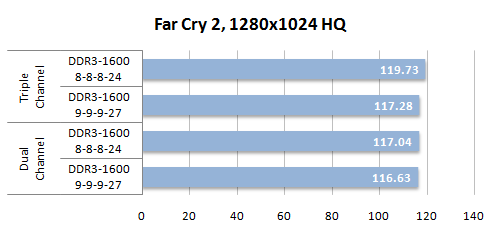
However, different number of memory channels may still tell on the gaming performance in some titles. For instance, FarCry 2 reveals 2% performance drop when we switch from three to two memory channels. Nevertheless, this is a truly ridiculous difference, especially against the background of the 33% drop of the theoretical peak bandwidth.
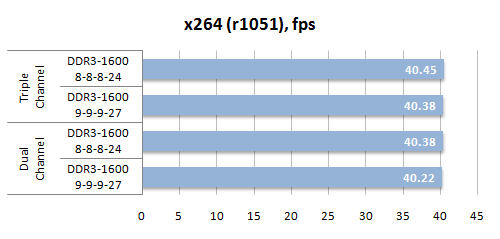
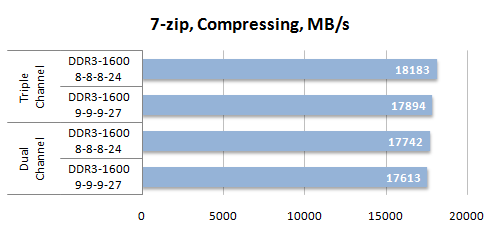
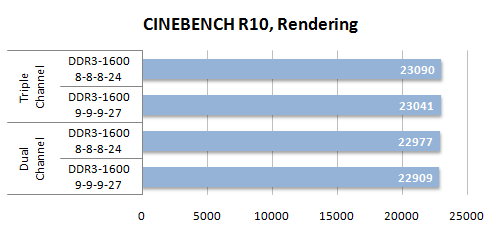
In fact, the effect from losing one of the memory channels can only compare with setting less aggressive memory timings. For example, the results of our tests show that dual-channel DDR3-1600 is in most cases faster than triple-channel DDR3-1200 SDRAM.
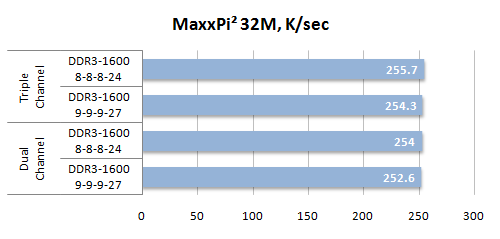
According to the results of MaxxPi2 benchmark, dual-channel DDR3-1600 SDRAM with 8-8-8-24 timings can provide almost the same level of practical performance as triple-channel DDR3-1600 with 9-9-9-24 timings.
So, using dual-channel memory in Core i7 systems instead of triple-channel DDR3 SDRAM recommended by Intel is a totally acceptable solution that allows to save some money and at the same time lose not too much of the performance. That is why we strongly recommend checking out dual-channel memory kits instead of triple-channel ones made of 1GB modules. However, you should remember about one thing. Most high-speed dual-channel 4GB kits are initially designed for LGA775 systems and require higher voltage settings. DIMM voltage increase is a painful question for LGA1366 platforms, so when you will be choosing a dual-channel memory kit for a Core i7 system, keep an eye on its ability to work without any serious voltage increase.
Conclusion
It is pretty hard to make any definite conclusions based on the obtained results. Nevertheless, we can undoubtedly say that choosing RAM for an LGA1366 system is a very versatile task. On the one hand, memory speed and timings do not have any serious effect on the LGA1366 systems performance. Things have barely changed here compared with the previous generation systems. Namely, DDR3-1600 SDRAM working in an overclocked system provides just a slight performance increase over the slower memory working at 1200MHz. Memory timings have the same insignificant effect on performance. Moreover, additional tests showed that Core i7 processors may do just fine even with dual-channel memory subsystem: the performance will drop just a tiny bit in this case.
At the same time, I am sure there will be some enthusiasts who will disagree with the conclusions made in the previous paragraph. This particular group will be the main users of high-speed triple-channel memory. So, if the performance difference between the today’s testing participants is crucial for your needs, then triple-channel DDR3-1600 kits will be a perfect choice for you. Memory modules working at this frequency give you a lot of flexibility during overclocking and do not require any significant voltage increase of the CPU Uncore. Moreover, overclocker DDR3-1600 may prove very effective with aggressive timings at lower operational frequencies.
One of the solutions that can become enthusiasts’ choice is the 6GB Corsair Dominator TR3X6G1600C8D kit we have tested today, which is available in retail freely. At the same time, we are not ultimately impressed with this particular solution, because other memory makers can currently offer somewhat better timings combinations at the same price. Besides, the massive cooling system topping these memory modules may cause some problems during system assembly if there is a large CPU cooler involved.
In conclusion I would only like to add that the need to install 6GB of DDR3-1600 memory into systems from the high-end price segment rests on pretty shaky ground. Practical experience and common sense suggest that this amount of memory is way too big. Triple-channel 3GB kits, like Corsair Dominator TR3X3G1600C8D, or even dual-channel kits of two 2GB modules requiring not very high voltage settings may be a smarter and more justified choice in this case.